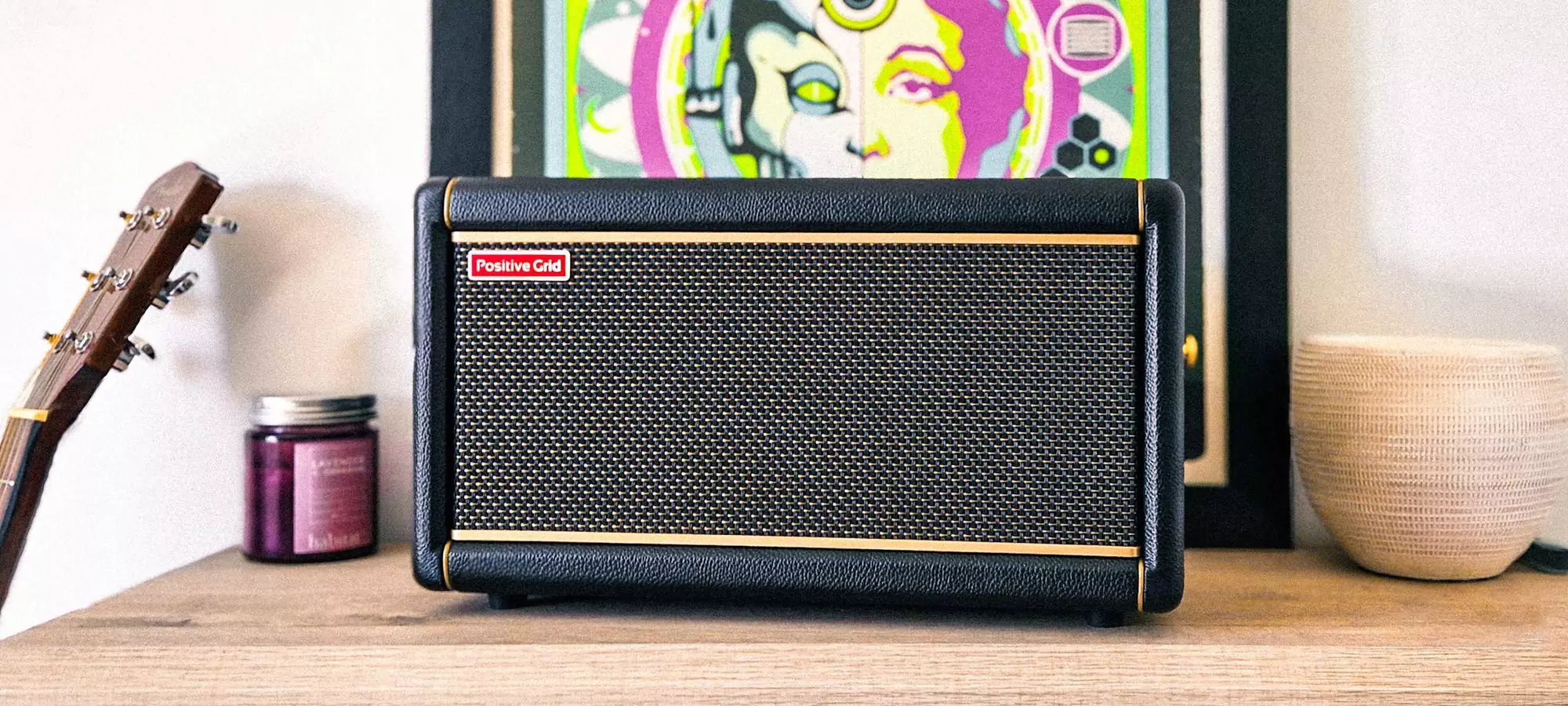Last updated on:
July 30, 2025
Golf practice used to depend on weather, daylight, and course availability. Home golf simulators changed this reality. They let you practice your swing, play virtual rounds, and improve your game from your garage, basement, or spare room.
A quality home golf simulator does more than entertain. It provides accurate feedback on your swing, tracks your progress, and offers professional-level analysis. This technology helps golfers at every skill level identify weaknesses and improve their performance.
The right simulator transforms unused space into a valuable training facility. It saves money on range fees and green fees over time. Most importantly, it lets you practice consistently, which is the key to golf improvement.
Understanding Golf Simulator Components
Launch Monitors
Launch monitors form the heart of any golf simulator system. They track ball flight data and club performance metrics. Two main types exist:
Radar-Based Systems use Doppler radar to track ball flight and club movement. They work well outdoors and indoors. TrackMan and Flightscope produce the most accurate radar systems. These units cost more but provide tour-level accuracy.
Camera-Based Systems use high-speed cameras and infrared sensors to capture ball and club data. They work only indoors but cost less than radar systems. Popular options include SkyTrak, GC3, and Uneekor models.
Software Platforms
Golf simulation software creates the visual experience and game play options. Quality software includes:
- Multiple famous golf courses
- Practice range modes
- Skills challenges and games
- Detailed shot analysis
- Progress tracking over time
Popular software platforms include TGC 2019, E6 Connect, and GSPro. Some launch monitors include proprietary software, while others work with multiple platforms.
Physical Setup Components
A complete simulator requires several physical components:
- Impact Screen: Absorbs ball impact and displays the virtual course
- Projector: Creates the visual display on the screen
- Enclosure: Contains errant shots and defines the hitting area
- Hitting Mat: Provides a realistic surface for shots
- Net System: Catches balls and protects surrounding areas
Space Requirements
Minimum Dimensions
Home golf simulators need specific space requirements for safe, comfortable use:
- Height: 9 feet minimum, 10 feet preferred for full swings
- Width: 10 feet minimum for comfortable stance and swing
- Length: 15 feet minimum from hitting area to screen
- Behind Ball: 7 feet minimum for backswing clearance
Ceiling Height Considerations
Most indoor golf simulators require a clearance space of 9 feet tall minimum to function, but 10 feet is ideal for a full swing without worrying about hitting the ceiling. Taller golfers and those with upright swings need more clearance.
Room Location Options
Garage Setups offer the most space and easy installation. They typically have high ceilings and concrete floors that work well for simulator installations.
Basement Installations provide year-round climate control but may have ceiling height limitations. Check structural requirements before installation.
Spare Room Conversions work for compact systems but require careful measurement to ensure adequate space.
Top Home Golf Simulator Recommendations
Best Overall: SkyTrak+ Complete Package
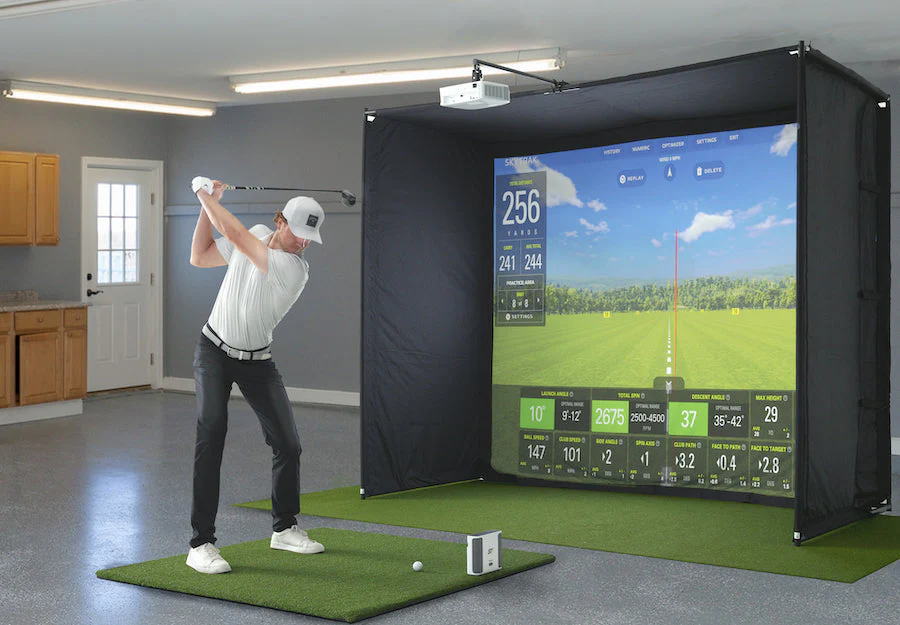
The SkyTrak+ delivers professional-grade accuracy at a reasonable price. This photometric launch monitor captures essential ball flight data and works with multiple software platforms.
Key Features:
- Accurate ball speed, launch angle, and spin data
- Compatible with TGC 2019 and E6 Connect software
- Works indoors and outdoors
- Compact design fits various spaces
- Metal case for durability
Best For: Golfers who want accurate data and course play without breaking the budget. Works well for skill levels from beginner to low handicap.
Price Range: $5,000-6,000 (complete package)
Best Premium Choice: TrackMan 4
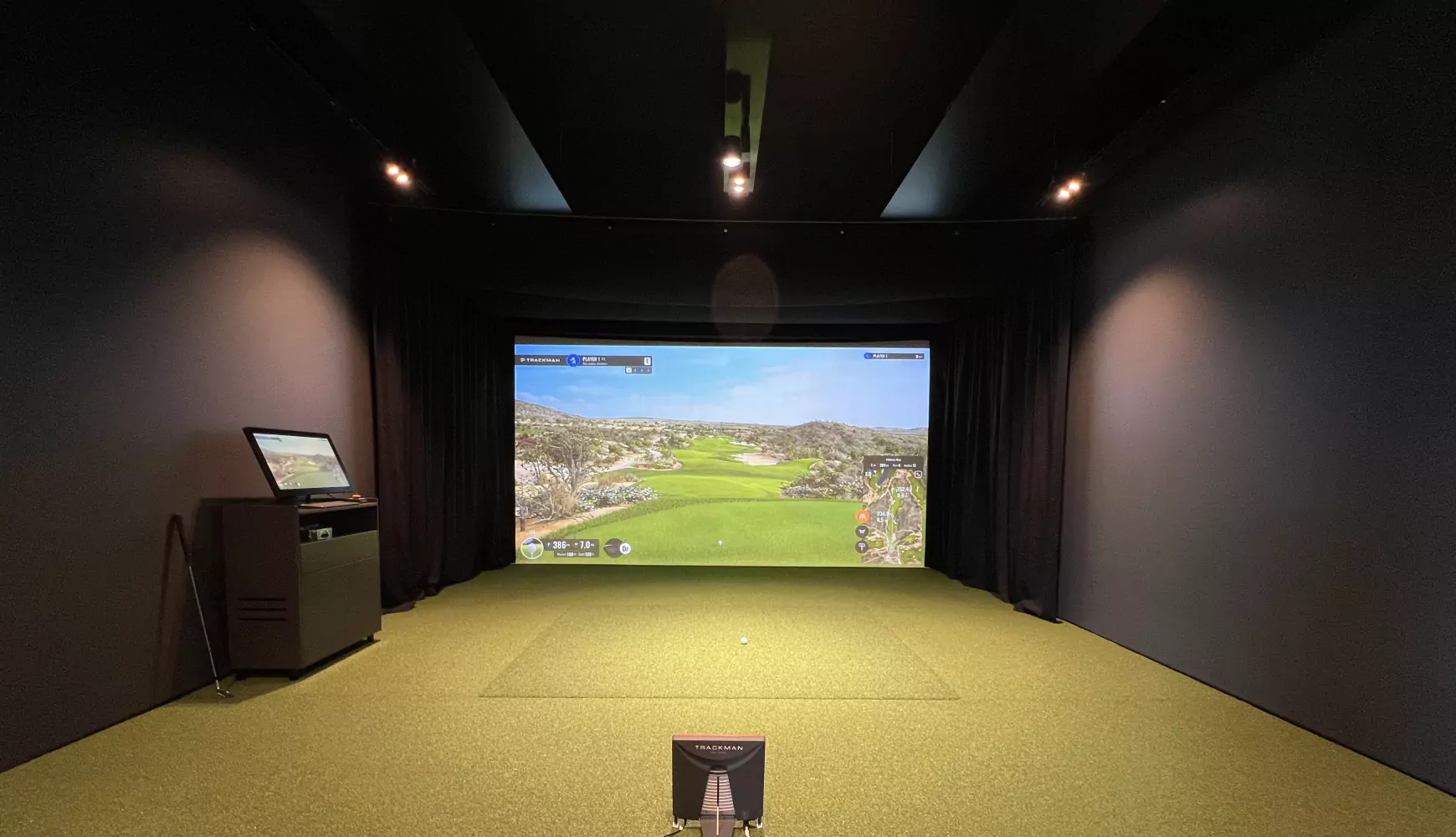
The TrackMan 4 represents the gold standard in golf launch monitors. Professional tours and top instructors rely on TrackMan technology for its unmatched accuracy.
Key Features:
- Dual radar technology for complete ball and club tracking
- 27 different data parameters
- Works indoors and outdoors seamlessly
- Professional software suite included
- Real-time 3D ball flight tracking
Best For: Serious golfers and professionals who demand the highest accuracy and most comprehensive data analysis.
Price Range: $20,000-35,000
Best Value: GC3 Net Package
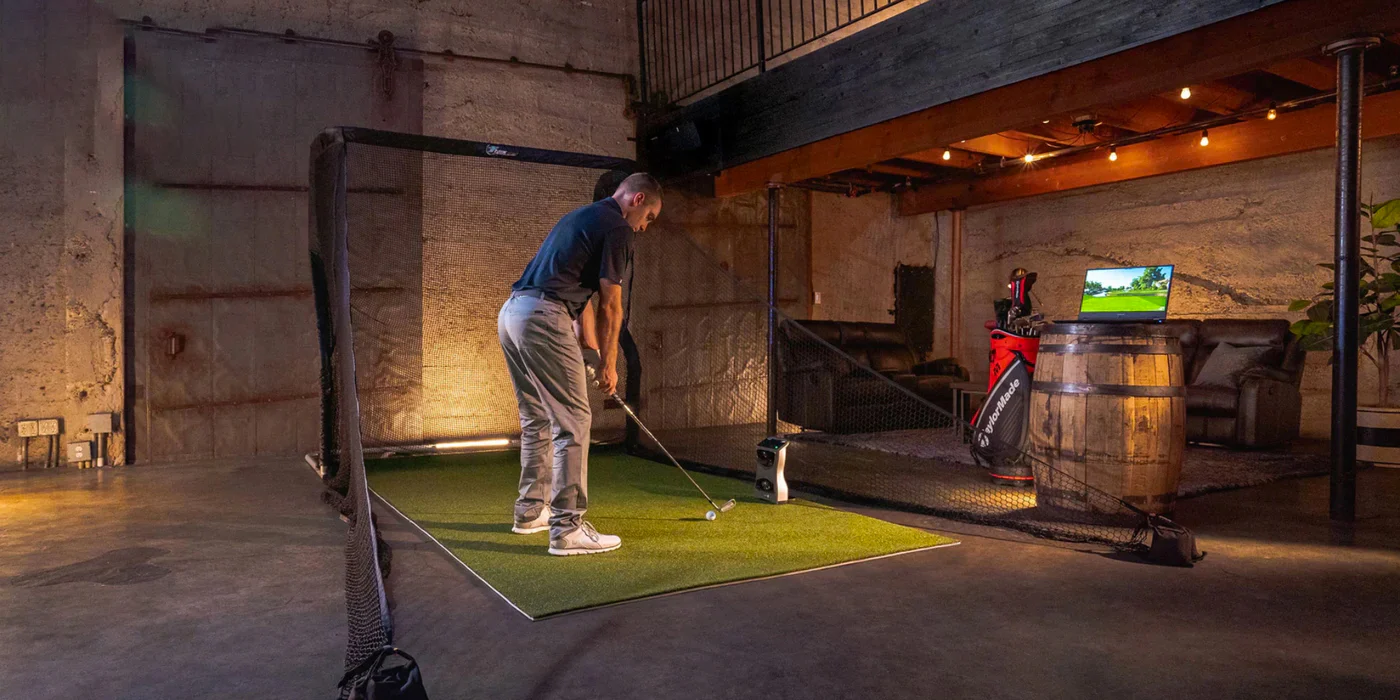
The GC3 Net & Screen package offers an attractive price point and can go from a training net to a full golf simulator with the screen and attachment bar.
Key Features:
- Accurate ball speed, spin, and launch data
- Compact side-mount design
- FSX software included
- Upgrade path to full simulator
- Professional-grade sensors
Best For: Golfers who want accurate practice data with the option to expand to full simulation later.
Price Range: $10,000-12,000
Best Budget Option: Garmin Approach R10
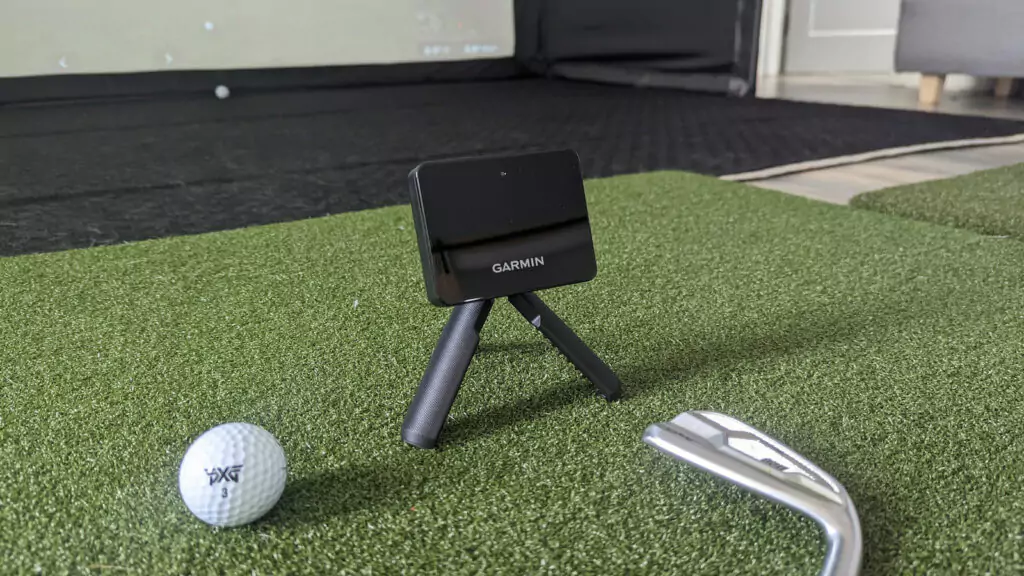
The Garmin Approach R10 makes golf simulation accessible to budget-conscious golfers. While not as accurate as premium options, it provides valuable practice feedback.
Key Features:
- Portable, battery-powered design
- Works with Garmin Golf app
- Video swing analysis
- Basic ball flight data
- Indoor and outdoor use
Best For: Casual golfers who want to practice at home without major investment. Good for basic swing feedback and entertainment.
Price Range: $600-800
Best for Small Spaces: Uneekor EYE MINI Lite
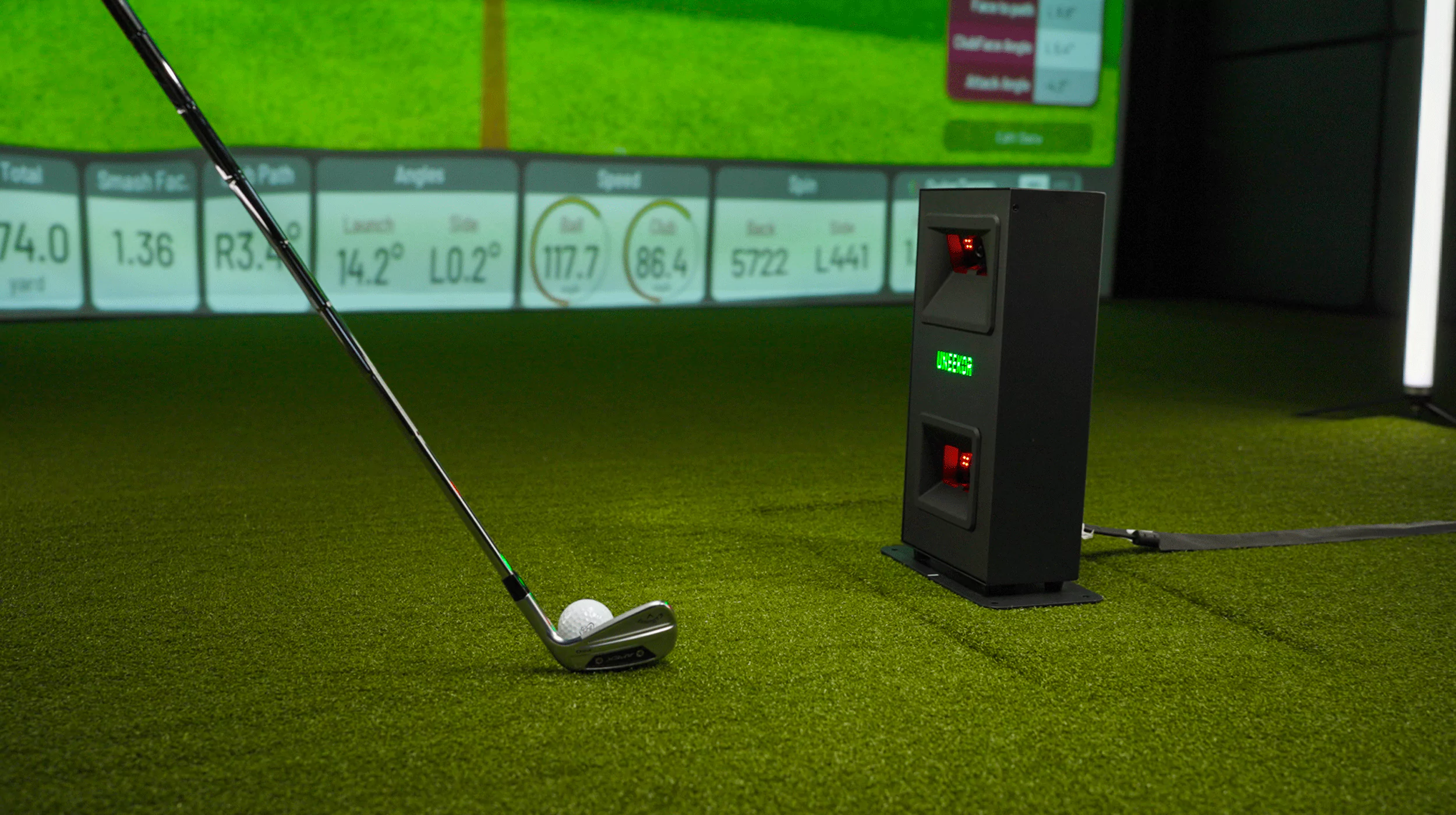
The Uneekor EYE MINI Lite ranks as one of the best golf launch monitors for home golf simulators because of its small space requirements.
Key Features:
- Ceiling-mounted design saves floor space
- Accurate ball and club data
- Works in tight spaces
- Multiple software compatibility
- Professional-grade accuracy
Best For: Homeowners with limited space who still want accurate simulation data.
Price Range: $2,500-3,500
Essential Features to Consider
Data Accuracy
Accurate ball speed, launch angle, and spin rate measurements are crucial for meaningful practice. Look for systems that measure actual ball flight rather than estimating values.
Software Options
Multiple software platforms provide variety and prevent boredom. Systems that work with TGC 2019, E6 Connect, or GSPro offer the most course options and regular updates.
Club Compatibility
Ensure your chosen system works with all your clubs, including drivers, irons, and wedges. Some budget systems struggle with short irons and wedges.
Ease of Setup
Consider how much time you want to spend setting up before each practice session. Some systems require alignment and calibration, while others are ready instantly.
Durability
Home simulators get regular use and need to withstand thousands of ball impacts. Look for systems with proven reliability and good warranty coverage.
Installation and Setup Tips
Room Preparation
Paint walls and ceiling dark colors to reduce light reflection and improve image quality. Remove or secure any breakable items in the hitting area.
Lighting Considerations
Avoid fluorescent lights that can interfere with camera-based systems. LED lighting works best and provides consistent illumination.
Flooring Options
Artificial turf or commercial hitting mats provide realistic feel and protect underlying floors. Ensure mats lay flat to prevent trips and inconsistent lies.
Safety Measures
Install proper netting or enclosures to contain errant shots. Even accurate golfers occasionally mishit balls that can damage walls or objects.
Maintenance and Care
Regular Cleaning
Keep impact screens clean and free of dust. Clean camera lenses and sensors regularly to maintain accuracy. Replace hitting mats when they show significant wear.
Software Updates
Keep simulation software updated to access new courses and features. Regular updates also fix bugs and improve performance.
Equipment Calibration
Most systems require occasional calibration to maintain accuracy. Follow manufacturer guidelines for calibration frequency and procedures.
Making Your Decision
When choosing a home golf simulator, consider your space limitations, budget, and accuracy needs. The SkyTrak+ offers the best balance of price and performance for most golfers. Those wanting professional-grade accuracy should consider the TrackMan 4. Budget-conscious golfers will find good value in the Garmin R10.
Remember that a golf simulator is an investment in your game improvement. Choose a system that matches your current skill level while providing room for growth. Quality simulators last for years and provide countless hours of practice and entertainment.
Consider your specific needs, available space, and long-term goals when making your final decision. A well-chosen simulator will transform your golf game and provide year-round practice opportunities that weather and daylight cannot interrupt.
![image of a customer service representative (focusing on workspace) [background image]](https://cdn.prod.website-files.com/686ff0f42c677102ebc56fac/688abd03fd7252d5ec2f1f9b_environment-29-688abce54a72c.webp)





